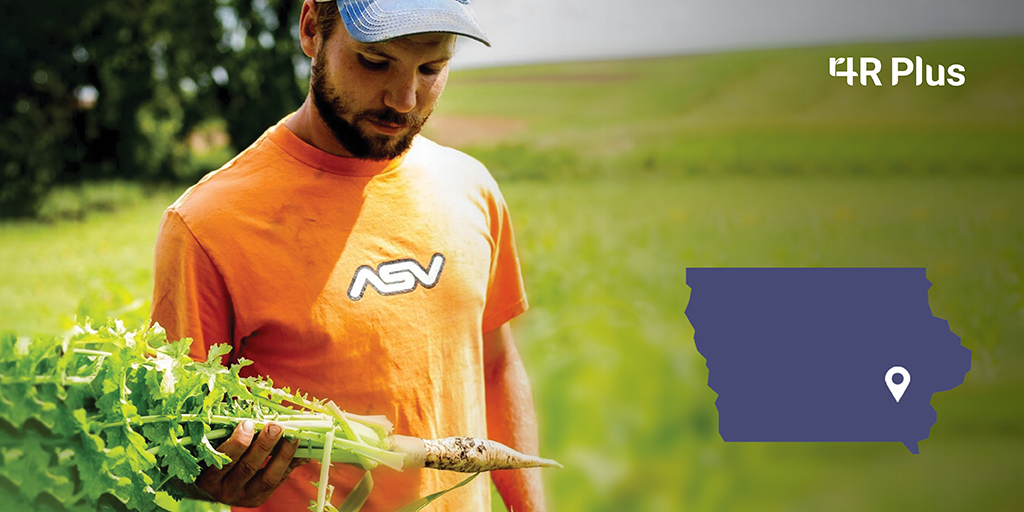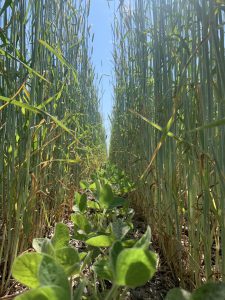
Michael Vittetoe is feeling fortunate as a result of his experiences terminating rye cover crops. He farms in Washington County, one of the few Iowa counties not dealing with drought conditions on a regular basis in 2021. Decent soil moisture levels – combined with fine-tuning his relay cropping strategy – have his corn and beans trending toward above-normal yields.
Several years ago, before he began using cover crops, Vittetoe was terrified of water hemp. “It was everywhere, and we couldn’t kill it. We were spending all kinds of money on herbicides,” he added. “And when you’re talking about herbicide programs that are getting north of $50 or $60 per acre, you wonder how that’s going to work over the long term.”
Vittetoe has learned that delaying cover crop termination as long as possible helps control weeds. “I’m not so worried about the weeds now,” he said.
His 2021 planting season started earlier than ever, with his first field of soybeans in the ground on April 5. “We knew there was a cold rain coming around the 10th, so we only planted one field,” he said. “I’m glad we held off because we got 3.5 inches of cold rain, followed by a cold week.”
He got about one-third of his soybeans planted, then switched to corn the last week in April. Once all his corn was planted, he switched back to soybeans the beginning of May, planting about another one-third. According to Vittetoe, ground conditions were great at that point, but the forecast was switching back to cold and wet.
Timing cover crop termination
Unlike many parts of Iowa, he saw plenty of rain in May. Those rains meant he could hold off terminating cover crops in soybean fields. The rains also meant he couldn’t finish planting soybeans. Once the calendar switched to June, conditions switched from cold and wet to hot and dry very quickly. This resulted in challenging planting conditions in fields with varying levels of residue. “Anywhere we had ground cover, there was moisture right at the surface; but we were dry 2-plus-inches deep where we had no cover.” he said.

By mid-June, after finishing drilling soybeans – Vittetoe began seeding a warm season mix for cattle grazing – he faced a dry period. “I had to go 2 inches deep just to find moisture under residue. I quit seeding to wait for rain,” he said.
Observations within one field
The corn was starting to roll. But anywhere there was heavy ground cover, there was also some moisture right at the surface.
As an example, Vittetoe described a patch of land where he grew corn in 60-inch and 30-inch rows side by side in 2020. The residue between the two 30-inch rows was heavy, while there was much less residue between the 60-inch rows. He drilled oats into the soil this spring, then drilled in soybeans later. “I could drill soybeans in 1 inch deep in the residue. I had to go 3 or 4 inches in the soil with no residue to find good moisture,” he explained. “The moisture gradient changed that fast within a couple feet all across the fields.”
Vittetoe also noticed the strips with residue had very little to no weed pressure, “but on the strips without residue, we had heavy weed pressure.”
Planting green cover crops
“The twin-row rye was still alive, about knee high, when we planted corn. We went in and sprayed it with Roundup to terminate the rye in our cornfields within a few days of planting, prior to emergence,” Vittetoe explained. “We planted soybeans into the same twin-row rye cover crop setup we had for corn, and just let the rye go until the first week of June.”

After terminating the rye in soybeans, about a week later, he was rolling it down because it was 5 feet to 6 feet tall. “We had beans that had the trifoliate out underneath getting stretched for sunlight, so we wanted to open the canopy. The rolled rye made a nice mat between the 30-inch rows,” he said.
The heat in June was tough on the beans planted into the tall rye. “You compare the way our beans look to some of the neighbors’ beans, whether they’re no-till or tilled, and our beans are, for the most part, shorter,” Vittetoe added. “But they’re really starting to come on now.”
Balancing termination timing, moisture conservation and weed control
Vittetoe said he would have terminated the cover crops sooner to conserve moisture if he hadn’t gotten rain in early May. “That’s where making the decision to terminate your cover crop is a big one. Once you kill it, you can’t bring it back. If you kill it early and then it rains, you shoot yourself in the foot.”
On the other hand, terminate too early and you risk bigger weed problems. “We had one field where the rye was really big and aggressive and going after a lot of fertility. It was on 10-inch rows instead of twin rows. We planted soybeans in that field about May 1 and killed the rye right after we planted the beans. And the difference in weed control in that field versus the fields we terminated the rye later is pretty astounding.
“You’re hard-pressed to find very many weeds out in our fields that were terminated later. That was definitely an eye-opener,” Vittetoe said.
Learn more about Vittetoe’s farm by subscribing to his YouTube channel.
Click here to ask Michael Vittetoe a question about the farming operation.
